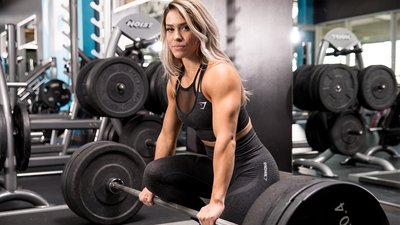Are deadlifts the single best exercise to build both the lower and upper body? Can you gain more strength and size doing them than any other exercise? The jury is out—and will probably stay out on that question. But there is no question that if you're serious about size, deadlifts need to be a regular part of your program. The real question is: What's the best way to do a deadlift?
To try to get a fix on this question, I assembled a group of five experts in the fields of strength and conditioning and sports medicine. We agreed up front that every human body has its own unique angles, geometry, and movement patterns, but these "secret weapons" should still apply to nearly all lifters.
Secret Weapon 1: Maintain a Stiff Torso and Engage Your Hips
Contraction of a muscle will always make a joint stiffer. A stiffer joint—in this case, the spine—is less flexible, but also less prone to disc injuries and capable of generating more force. Think about jumping. Your ankle must be stiff when you hit the ground or you might turn it, resulting in a sprain. The higher your jump, the stiffer your ankle must be.
It's the same principle for deadlifting, says Stuart McGill, Ph.D., a noted expert on spine biomechanics and, with elite powerlifter Brian Carroll, co-author of "The Gift of Injury." For a superior deadlift, he says, you need to "lock in" stiffness in both your spine and core.
"Stiffening your spine transfers most of the load to your hips, which in turn transfers more of the load to your thighs for more leg drive," says McGill. "A stiffer core also helps send a signal to your brain that triggers a strong neuromuscular response, again improving your ability to handle heavier weights while preventing injury."
I asked Dr. McGill for specific exercises lifters could do to decrease the risk of injuries—specifically lower-back injuries—common among deadlifters. He suggests four exercises that can create a "core of iron," enabling your spine to withstand the compressive force of the lift, redirect neural drive to the legs during the lift, and avoid injury.
McGill's four exercises for core strength include stir-the-pot, side bridge, and McGill's modifications for the bird dog and the curl-up.
Secret Weapon 2: Work from Blocks or Pins
I suggest that every person with a fitness or physique goal should start their deadlifts from blocks or pins. An elevated starting point of about 6 inches should be enough to reduce the risk of injury.
According to strength coach Dan John, "The bar, for most men and many women, is too low to the ground. There is no scientific basis for the bar being at the height it is, so I teach people to start from either one inch below or above the knees when you're lifting from a rack or box. I teach it as a hinge, not a leg press into a hinge."
Functional movement expert Dr. Cody Dimak notes: "Unless you're a powerlifter, you don't have to pull from the floor. Most people would get more benefit from pulling off blocks or doing rack pulls. Either approach would help facilitate a good lifter's wedge and minimize lumbar motion throughout the lift."
Secret Weapon 3: Find Your Optimal Foot Position
Your anatomy, which can't be changed, dictates the best foot position for you to produce maximum hip drive. Without using your optimal foot position, you run the high risk of dumping the deadlifting forces into your lower back. This can result in disc herniation or sciatica, pain along the nerve that branches from your lower back through your hips and buttocks and down each leg.
So how do you find your best foot position?
"I typically start by giving the person a hip assessment," Dimak says. "Then, I use that assessment to find their optimal foot placement. Armed with that knowledge, I start loading in a range that is appropriate for that individual."
This concept comes from the idea of knowing your individual hip anatomy. Some people are blessed with round ball and sockets of the hip joint but most of us who have been athletic in our youth have oblong-shaped femoral heads, along with other natural abnormalities of the thigh bone.
If you're going to deadlift high loads, get your hips evaluated by a professional. It'll be the best few hundred dollars you've ever spent. It's much cheaper than rehabbing the disc injury you get from deadlifting with a foot position that's not right for you.
Secret Weapon 4: Get Your Head Right
Even with all the tricks, tips, and hacks in the world at your disposal, you can't escape that your mental approach and process to deadlifting trumps all else.
We all have lifting partners and we all like to BS when we're training, but there's a proper time and place for that.
"Deadlifting, as well as any other skilled lift, should have zero distractions, zero joking, and zero rubbernecking," says Brian Carroll.
People who walk up to the bar dancing, smiling, or joking are already setting themselves further back than they know, Carroll says.
"In my world, there's no talking during a lift, no smiling," he says. "Smiling decreases neural drive and lessens the chance of producing ultimate power and force. A happy face is a satisfied one, and a satisfied person is not engaging their body's fight or flight response to summon maximum power, safety, and injury resilience."


